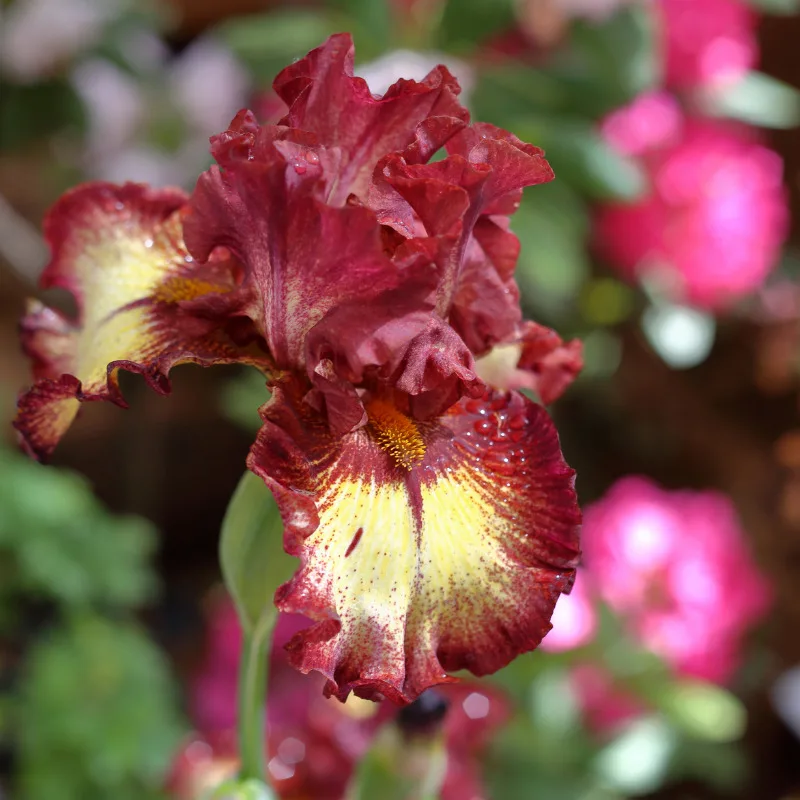Plant bulbs in January to get a head start on growing gorgeous flowers for cut flower production.
Inside of a heated greenhouse, triteleria, anemone, iris and crocosmia should be planted for early spring bloom.
The secret to local success as a cut flower grower is to beat out your competition by having gorgeous cut flower blooms in spring, earlier than your competitors.
So why not earn a little money from your greenhouse by growing cut flowers?
Don't forget to grow a few herbs and vegetables for the dinner table too!

Plant Iris Bulbs In January
Iris should be planted the first Friday of January.
Be sure to plant the iris rhizomes in free draining, organic potting soil and do not bury the rhizome.
Iris rhizomes lay on top of the potting medium.
Their long roots go down into the soil to anchor the growing iris.
As long as the soil is warm enough the rhizomes will begin growing.
Gardeners can expect iris blooms by April.
Iris come in a rainbow of colors so plant enough of each to make nice bouquets.
Remember to plant some bearded iris too.

Plant Anemone And Triteleria Bulbs In January
The second Wednesday and Thursday of January bring another round of planting for cut flower production.
Plant anemone on the second Wednesday and the flowers should be ready for cutting in April around the same time as the iris.
The second Thursday of January is the day to plant triteleria bulbs.
The flowers from these bulbs will not be ready for cutting until May.

Plant Crocosmia Bulbs In January
The third Tuesday of the month, plant numerous crocosmia tubers.
The crocosmia will not bloom until July typically, but they will be nicer than the ones grown in the open that have been exposed to the elements of the weather.
Typically greenhouse grown crocosmia are taller than ones grown in the garden.

Vegetables, Herbs And Annual Flowers Help Offset Heating Cost
If you are looking for a way to offset the cost of heating the greenhouse or tunnel house this early in the month, plant carrots, sugar snap peas, cabbage, onions, celery and parsley.
These herbs and vegetables will be a tasty treat this early in the year.
Plant seeds of dianthus, pansy, statice and snapdragon as well.
Keep in mind when choosing which varieties of dianthus, statice and snapdragon to grow that there are varieties meant for cut flower production.
Choose those varieties for great filler materials for bouquets.
Keep inter-planting bulbs, herbs, flowers and vegetables throughout the month of January.
Not only will the mixed plantings benefit one another by keeping insect populations down, but excess space will be filled with harvestable crops.
As one crop is removed, add a new crop to take its place.
Bulbs and Rhizomes
Dive into the fascinating world of bulbs and rhizomes with our curated collection of blog posts! Whether you're a seasoned gardener or just starting your journey, you'll find everything you need to plan, plant, and care for these stunning plants. From classic spring favorites like tulips and daffodils to summer showstoppers like gladiolus and cannas, our posts cover a wide variety of blooms to suit any garden style.
Learn how to choose the best bulbs and rhizomes for your region, plant them at the right time, and care for them season after season. With expert tips on soil preparation, watering, and pest resistance, you’ll be equipped to create a garden that’s vibrant and thriving.
Explore the endless possibilities and let these versatile plants bring bursts of color and texture to your garden year-round. Start planning your dream garden today!
Daylilies: Attractive, Colorful, Easy To Grow Garden Gems
Daylilies are popular garden plants that are colorful, easy to grow and multiply rapidly. They are also drought tolerant.
Worselya rayneri Culture And Propagation
Learn how to grow, flower and propagate the endangered plant, commonly known as the Empress Of Brazil, Worseyla rayneri.
How To Grow Amaryllis
Learn how to grow Amaryllis from seed as well as how to care for your Amaryllis plant indoors and what to do with it after flowering.
Spring Flowering Bulbs: The Cutting Garden
Plant spring flowering bulbs in the greenhouse or even indoors in February and March for gorgeous blooms in spring or mid-summer.
Forcing Bulbs Indoors For Early Spring Blooms
Forcing bulbs indoors is a great way for those without greenhouses to have flowers in bloom during the winter months.
Blooming Brilliance: Mastering Spring-Flowering Bulbs in Hot Climates
Discover the secrets of coaxing bulbs to bloom in hot climates. Get expert tips for vibrant, resilient floral displays.
Brighten Your Garden This Spring With Miniature Daffodils
Brighten your garden this spring with miniature daffodils! Discover their vibrant colors, unique varieties, and easy-care charm.
How To Grow And Care For The Albuca Species
Learn how to grow and care for the Albuca species. While most people start with a live plant, seed starting information is also included.
















